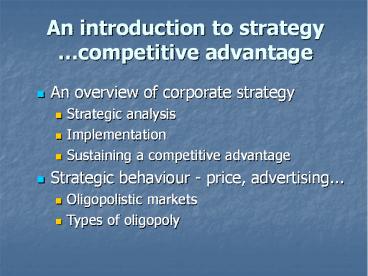An introduction to strategy - PowerPoint PPT Presentation
1 / 16
Title:
An introduction to strategy
Description:
An introduction to strategy competitive advantage An overview of corporate strategy Strategic analysis Implementation Sustaining a competitive advantage – PowerPoint PPT presentation
Number of Views:64
Avg rating:3.0/5.0
Title: An introduction to strategy
1
An introduction to strategycompetitive advantage
- An overview of corporate strategy
- Strategic analysis
- Implementation
- Sustaining a competitive advantage
- Strategic behaviour - price, advertising...
- Oligopolistic markets
- Types of oligopoly
2
Strategic analysis
- 1. Strategic core
- specific assets competitive advantage
- 2. Analysis of the environment
- e.g. demand analysis, suppliers, finance,
competitors - e.g. government policy, potential competitors
- e.g. social cultural changes
- 3. Choosing a strategy
- market selection e.g. profit, growth, market
share - product positioning
3
Implementation of strategy
- Business organisation control
- Strategic linkages
- within and between firms
- vertical or horizontal linkages
- e.g. alliances or joint ventures
4
Sustaining a competitive advantage
- 1. Anticipate rivals actions
- 2. Control rivals actions
- erect barriers to entry e.g. limit pricing,
patenting - 3. Credibility
- 4. Strategic linkages
- 5. Sun Zhu (500BC)
- he who occupies the field of battle first and
awaits his enemy is at ease he who comes later
to the scene and rushes into the fight is weary. - first-mover advantage
5
Oligopoly
- Exists when
- small number of firms
- interdependence
- Examples
- Tobacco, Motor Vehicles, Aerospace
- local petrol station
- Other characteristics?
6
Characteristics
- (i) Type of product
- homogenous or unique
- (ii) Blockaded entry exit
- e.g. scale economies (breweries)
- e.g. ownership of factors
- e.g. aggressive tactics (supermarkets,
newspapers) - (iii) Imperfect information
7
Types of oligoploy
- (i) Collusive
- co-operation, non-competition
- cartels
- (ii) Tacit collusion
- e.g. price changes
- kinked demand model
- (ii) Non-collusive
- competition
- game theory
8
Tacit collusion - kinked demand model
- Predictions
- Price stability
- Despite variations in costs
- Why?
- Rival firms match price cuts
- Rivals do not match price rises
- MC may rise but profit maximising P,Q are
unchanged - Construction of model
9
Non-collusive oligopoly
- Game theory
- how to gain a competitive edge and steal market
share - Firms players
- Behaviour strategic
- Rewards payoffs
- Simple model - two car dealers
- Act independently, rational
- Simultaneous decisions
10
Advertising a price - honest dealer
Dodgy dealer
Honest dealer
11
Advertising a price - honest dealer
Dodgy dealer
4. Worst outcome for Honest
1.If Dodgy High, Honest greater profit
Honest dealer
3. Best outcome for Honest
2. Ignoring Dodgy, profit is lower if
HonestHigh
12
Pricing decision - interdependent
- Outcome is uncertain
- Questions
- If Honest believes Dodgy will advertise a low
price, what is her best strategy? - Answer Advertise a low price
- But, Dodgy may not advertise a low price
- What is her best strategy if she believes Dodgy
will advertise a high price? - Answer Low price
- For Honest, low price strategy dominates the
high price strategy
13
Dominant strategy
- Definition
- is one that is always strictly better than
every other strategy for that player regardless
of the strategies chosen by other players. - Dodgy dealer asks the same questions
- Payoff matrix
- Dominant strategy low price
14
Advertising a price - dodgy dealer
Dodgy dealer
Honest dealer
15
Dominant strategy equilibrium
Dodgy dealer
Honest dealer
best strategy regardless of competitor strategy
16
Nash equilibrium - non-cooperative
- the outcome resulting from each firm making its
optimal decision based on their assumptions about
their rivals decisions. - equilibrium also low price
- A high, high strategy is superior, but unstable
- because one player could switch to a low price
- to gain market share...































